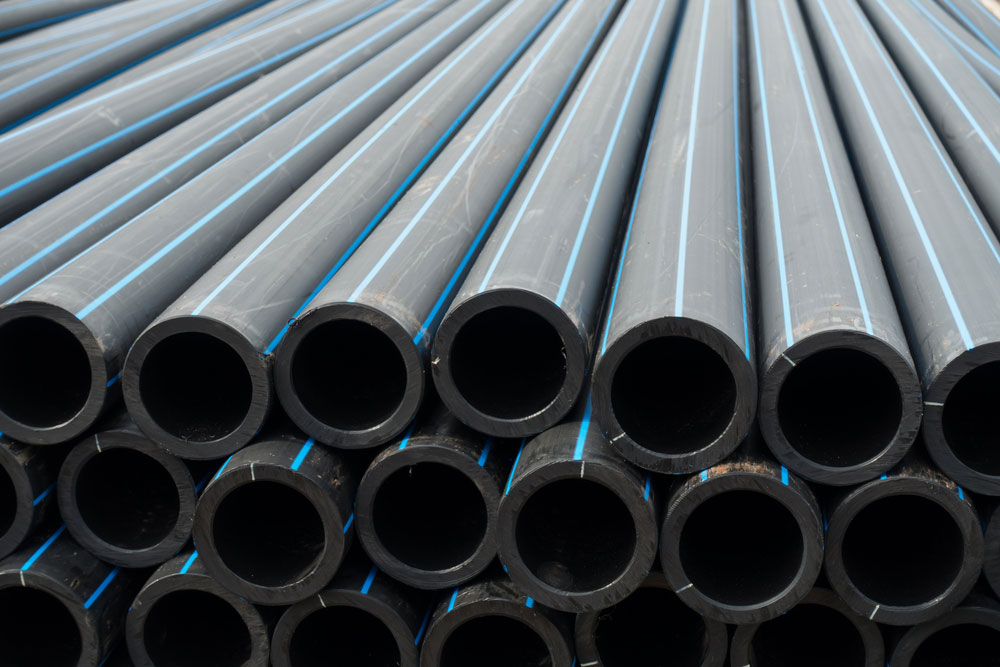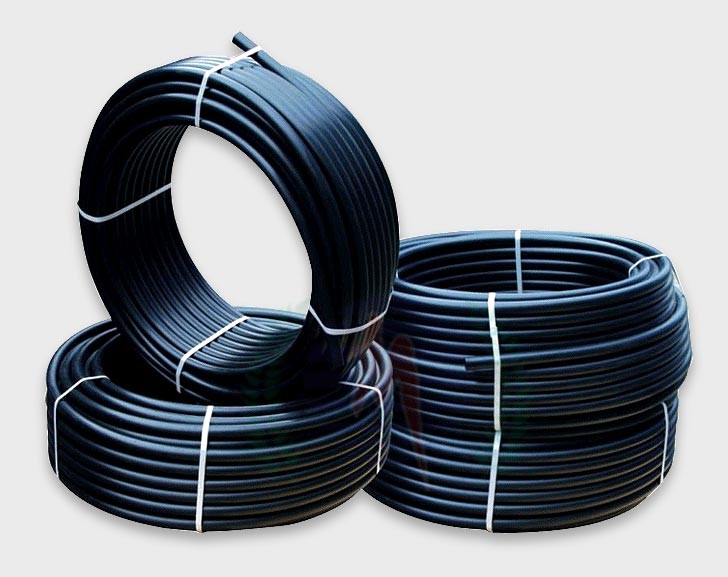How American Plastics HDPE Pipe for Oilfield Supports Oilfield Operations
Wiki Article
Explore the Production Process Behind High-Quality HDPE Pipe and Its Applications
The production procedure of high-grade HDPE pipes is elaborate and methodical. It starts with the option of basic materials that improve performance. Following this, ethylene undertakes polymerization to develop resin, which is then formed with extrusion. Quality control is critical, guaranteeing that the final item satisfies strict standards. Nonetheless, the trip of HDPE pipes does not finish with production. Their applications throughout numerous industries disclose a broader importance worth analyzing.Comprehending HDPE: Residences and Advantages

High-density polyethylene (HDPE) is a functional polycarbonate recognized for its sturdiness and resistance to various environmental variables. This material displays excellent tensile stamina, making it appropriate for requiring applications. Its low-density structure adds to a light-weight product, assisting in ease of taking care of and installation. HDPE additionally showcases exceptional resistance to chemicals, which reduces degradation when exposed to severe substances.
The product's reduced dampness absorption further boosts its long life, making it perfect for use in pipes and storage space tanks. Furthermore, HDPE is resistant to ultraviolet (UV) radiation, ensuring that items maintain their honesty even when subjected to sunlight. Its adaptability enables for the production of intricate shapes without endangering stamina. The eco-friendly nature of HDPE, frequently obtained from recycled products, includes in its appeal, advertising lasting practices in manufacturing. In general, these residential or commercial properties and benefits make HDPE a recommended choice for different commercial and consumer applications.
Resources Selection for HDPE Manufacturing
The choice of basic materials for HDPE production is important to validate the final product meets the desired requirements and top quality criteria. High-density polyethylene (HDPE) is primarily produced from polymerized ethylene, derived from nonrenewable fuel sources such as gas or unrefined oil. The quality of these feedstocks substantially influences the mechanical and thermal properties of the last HDPE.Additives additionally play a considerable function in enhancing HDPE's performance, including antioxidants, UV stabilizers, and colorants, which improve longevity and resistance to ecological aspects. The option procedure must think about not just the chemical make-up of the raw products but likewise their processing features to assure reliable production.
In addition, the sourcing of raw products should prioritize sustainability and compliance with ecological policies, as accountable methods are imperative in today's market. Ultimately, cautious resources selection lays the structure for creating top quality HDPE pipes appropriate for varied applications.
The Extrusion Process: Forming HDPE Pipe
The extrusion process plays a vital duty fit HDPE pipes, beginning with careful product prep work techniques that ensure suitable flow and consistency. Similarly vital is the style of the die, which straight affects the last dimensions and surface top quality of the pipe. With each other, these factors contribute significantly to the efficiency and top quality of HDPE pipeline production.Product Preparation Strategies
Reliable production of HDPE pipelines begins with thorough material prep work methods, especially the extrusion process. During this phase, high-density polyethylene material is first dried out to remove dampness, making sure ideal flow attributes. The resin is after that fed into the extruder, where it undertakes home heating and melting, transforming right into a thick state. This home heating process is very carefully regulated to preserve the material's integrity and performance. The liquified HDPE is forced with a die, shaping it into a continuous pipe kind. Correct temperature monitoring during extrusion is important, as it directly affects the material's properties and the last product top quality. Once shaped, the HDPE pipe is cooled down and reduced to specified lengths, ready for succeeding processing and applications.Die Style Significance
Precision in die design plays a vital function in the extrusion procedure of HDPE pipes. The die serves as the final shaping device, straight affecting the pipe's measurements, wall surface thickness, and surface finish. A well-designed die assurances consistent product flow, decreasing issues such as abnormalities and weak points. The geometry of the die should be enhanced to suit the particular buildings of HDPE, including its thickness and thermal habits during extrusion. In addition, the cooling price of the product as it goes through the die can considerably affect the pipeline's structural integrity. Spending in advanced die technology is important for manufacturers aiming to create top notch HDPE pipelines that satisfy market requirements and client assumptions.Quality Assurance Measures in HDPE Manufacturing
Although numerous aspects affect the top quality of HDPE pipeline production, effective quality assurance procedures are important to guarantee uniformity and dependability in the final item. Trick top quality control practices include rigorous material examination, confirming that the raw polyethylene satisfies well-known requirements for purity and thickness. During the extrusion process, criteria such as temperature level, pressure, and cooling time are closely kept an eye on to preserve dimensional precision and structural honestyOn top of that, post-production screening is crucial; makers commonly perform hydrostatic tests to analyze the pipe's strength and resistance to pressure. Visual assessments for surface area problems additionally boost quality guarantee. Certification from pertinent requirements organizations, like ASTM or ISO, supplies an added layer of trustworthiness. By implementing these detailed quality assurance measures, makers can minimize issues, improve efficiency, and ensure that the HDPE pipes fulfill the details requirements of various applications, inevitably causing client satisfaction and rely on the product.
Applications of HDPE Pipeline Throughout Industries
HDPE pipes are used throughout numerous fields due to their sturdiness and flexibility. In water circulation systems, they guarantee effective shipment, while in wastewater management, they give trusted services for waste transportation. In addition, farming watering networks profit from HDPE's resistance to corrosion and adaptability, making it an excellent selection for contemporary farming techniques.
Water Circulation Equipments
A significant variety of industries rely upon high-density polyethylene (HDPE) pipes for effective water distribution systems. Known for their toughness and resistance to rust, HDPE pipes are widely made use of in community water supply networks, farming irrigation, and industrial applications. Their lightweight nature helps with easy handling and setup, minimizing labor prices and time. In addition, HDPE pipes can accommodate different stress levels, making them suitable for both low and high-pressure systems. hdpe pipe suppliers Midland TX. The adaptability of the product allows for smooth integration right into existing infrastructure, decreasing the requirement for extensive excavation. HDPE's resistance to chemical seeping warranties that the water supplied continues to be secure and clean, making it a perfect option for preserving the high quality of safe and clean water across various markets.Wastewater Monitoring Solutions
Effective water get more info distribution systems additionally lead the way for innovative wastewater management services, where high-density polyethylene (HDPE) pipes play a considerable duty. Prominent for their resilience and resistance to rust, HDPE pipelines are ideal for transferring wastewater in different setups. Their flexibility enables very easy installation in complicated atmospheres, lessening the requirement for comprehensive excavation. Additionally, HDPE's smooth indoor surface reduces rubbing, improving flow prices and efficiency. These pipelines are likewise resistant to chemical leaching, making certain that pollutants do not jeopardize the surrounding environment. Industries, municipalities, and treatment centers significantly rely on HDPE pipelines for their dependability and longevity, making them a preferred selection for contemporary wastewater monitoring systems. This adaptability underscores the vital value of HDPE pipelines throughout countless applications.Agricultural Irrigation Networks
Agricultural watering networks benefit substantially from the usage of high-density polyethylene (HDPE) pipes, which provide efficient and reliable water delivery to plants. HDPE pipes are light-weight, making them simple to transport and set up, while their flexibility enables numerous arrangements in varied terrains. These pipes show exceptional resistance to corrosion, chemicals, and UV radiation, guaranteeing sturdiness in rough agricultural settings. Furthermore, their smooth interior surface area lessens friction loss, maximizing water circulation and decreasing power prices connected with pumping. The long life of HDPE pipelines, commonly going beyond half a century, adds to decrease maintenance and substitute expenditures. Farmers significantly count on HDPE pipes to improve irrigation effectiveness and advertise sustainable agricultural methods, ultimately leading to improved crop yields and source preservation.
Future Trends in HDPE Pipeline Technology
As the need for sustainable and reliable facilities expands, innovations in HDPE pipeline innovation are poised to change different industries. Emerging fads include the integration of wise technologies, such as sensing units and IoT capabilities, which assist in real-time monitoring of pipe problems, decreasing upkeep costs and protecting against leaks. In addition, the development of innovative manufacturing techniques, such as 3D printing, is making it possible for the production of facility, customized pipeline designs that deal with certain project demands.In addition, the concentrate on recycling and circular economic climate methods is driving the advancement of HDPE pipelines made from recycled materials, improving sustainability. Improved jointing methods, such as electro-fusion and mechanical fittings, are additionally improving installment efficiency and integrity. The growing emphasis on environmental regulations is pushing suppliers to take on greener manufacturing processes, guaranteeing that HDPE pipes not just fulfill market requirements but additionally cultivate a more sustainable future for infrastructure development.
Regularly Asked Questions
Exactly How Does HDPE Compare to Other Plastic Materials?
HDPE surpasses numerous other plastic products concerning toughness, chemical resistance, and flexibility. Its low density and high tensile stamina make it ideal for numerous applications, typically exceeding choices in both efficiency and long life.What Are the Environmental Influences of HDPE Production?
The environmental effects of HDPE manufacturing consist of greenhouse gas exhausts, power usage, and possible air pollution from making procedures. Additionally, improper disposal can result in dirt and water contamination, increasing issues regarding long-term eco-friendly effects.Can HDPE Piping Be Recycled?
Yes, HDPE pipes can be reused. Several facilities approve used HDPE for handling, transforming it right into new items. This recycling adds to sustainability efforts, lowering plastic waste while saving resources and energy in the production cycle.What Is the Lifespan of HDPE Pipes?

Just How Do Temperature Variants Impact HDPE Pipe Efficiency?
Temperature variants considerably impact HDPE pipeline performance, influencing adaptability and stamina. Heats can cause softening, while reduced temperatures might create brittleness, inevitably influencing the pipe's toughness and viability for numerous applications in varied environments.Report this wiki page